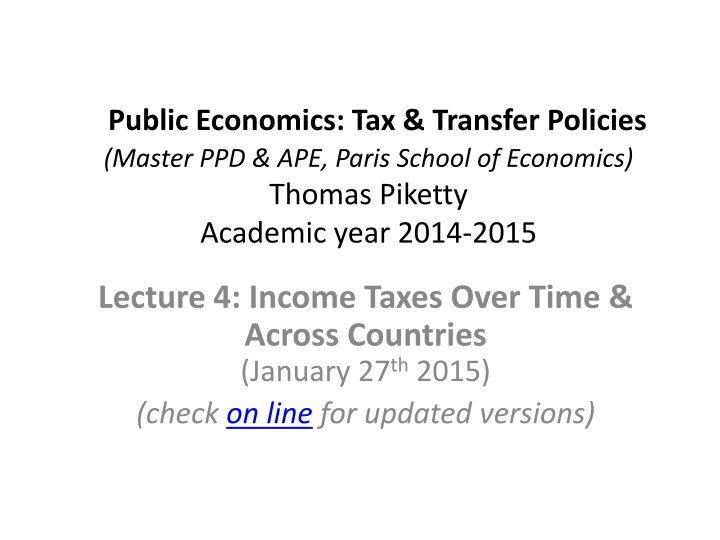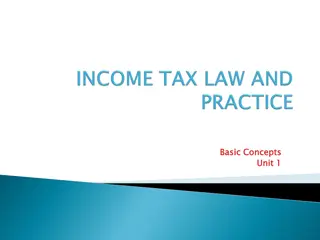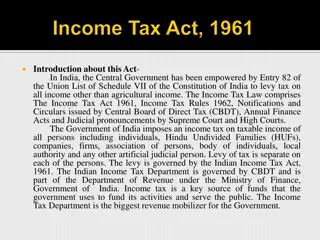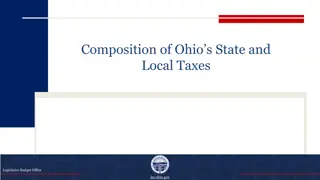Evolution of Progressive Income Tax Systems
The concept of modern progressive income tax, developed in the early 20th century in countries like the UK, US, France, India, and Argentina, is based on the principle of a comprehensive tax base encompassing various income categories. The system involves effective vs. marginal tax rates, different tax structures across countries, and considerations for taxing individuals or couples. The split system used in France, Germany, and the US, for example, can impact gender equality and labor supply decisions. The illustration with French 2013 income tax schedules provides insights into how income brackets and familial quotient systems influence taxable income calculations and tax rates.
Download Presentation

Please find below an Image/Link to download the presentation.
The content on the website is provided AS IS for your information and personal use only. It may not be sold, licensed, or shared on other websites without obtaining consent from the author.If you encounter any issues during the download, it is possible that the publisher has removed the file from their server.
You are allowed to download the files provided on this website for personal or commercial use, subject to the condition that they are used lawfully. All files are the property of their respective owners.
The content on the website is provided AS IS for your information and personal use only. It may not be sold, licensed, or shared on other websites without obtaining consent from the author.
E N D
Presentation Transcript
Public Economics: Tax & Transfer Policies (Master PPD & APE, Paris School of Economics) Thomas Piketty Academic year 2014-2015 Lecture 4: Income Taxes Over Time & Across Countries (January 27th2015) (check on line for updated versions)
The modern progressive income tax The modern progressive income tax was created in 1909 in the UK, 1913 in the US, 1914 in France, 1922 in India, 1932 in Argentina, etc., and is based upon the principle of a comprehensive tax base Comprehensive income tax: t = t(y) with y = total income from all income categories (wages + pensions + self-employment income + rent + dividend + interest + etc.) schedular income tax: different tax rates for different income categories (UK system in 19c)
Effective vs. Marginal tax rates Effective or average tax rate = t(y)/y t(y) progressive if and only if t(y)/y rises with y Marginal tax rate = t (y) t(y) convex = t (y)>0, i.e. t (y) rises with y Convexity implies progressivity (but not necessary: as we will see, U-shaped pattern of marginal tax rates when transfers are taken into account) Most progressive income taxes use a bracket system: fixed marginal tax rates within income brackets But one can also use continuous system Exemple of computations using tax schedules from France and the US: see excel file
Taxing individuals or couples? In many European countries (Scandinavia, UK, Italy, Spain,.), income tax t(y) is based upon individual income y: whether one lives in a couple or not is irrelevant In France, Germany & US (for bottom half of pop), income tax is computed at the level of married couples using split system ( quotient conjugual ): income tax = 2 x t[ (y1+y2)/2 ], with y1,y2= spouses incomes With t(y) convex, this favours unequal couples; if y1=y2, there is no tax advantage at all Key question: unitary household or not? The split system can reinforce gender inequality; the individual system favours female labor supply
Marginal vs average tax rates: illustration with French 2013 Income Tax Income brackets Marginal tax rate French 2013 income tax schedule (applied to 2012 incomes) (bar me de l'imp t sur le revenu (IR)) (see www.impots.gouv.fr) (%) ( ) 0,0% 0 5 964 5,5% 5 964 11 896 14,0% 11 896 26 420 30,0% 26 420 70 830 41,0% 70 830 150 000 45,0% 150 000 French "quotient familial" (QF) sytem: y = taxable income = annual income - standard deduction for profesional expenses (10%) n = number of units of QF (nombre de parts de QF): n=1 if single, n=2 if couple, n=2.5 if couple with 1 kid, etc. y/n = taxable income per QF unift (revenu imposable par part de QF) Income tax = n x t(y/n) (because t(y) is convex, it is better to have a high n)
Exemple with an annual income y = 100 000 and n=2,5 (couple with one kid) (about P99): 100 000 - 10% x 100 000 = 90 000 (standard deduction for profesional expenses of wage earners: 10%) 90 000 / 2,5 = 36 000 = taxable income per QF unit >>> marginal income tax rate = 30% Income tax per QF unit = 5.5% x (11 896 - 5 964) + 14% x (26 420 - 11 896) + 30% x (36 000 - 26 420) = 4 033 Total income tax = 2,5 x 4 033 = 10 081 >>> average income tax rate = 10 081 / 100 000 = 10,1% >>> average effective tax rate taking into account tax credits etc. = 0,85 x 10,1% = 8,6% >>>>> 8,6% << 30,0% , i.e. average rate << marginal rate
U.S. Federal income tax rates applied to 2013 incomes Note: This does not include the personal tax exemption ($3,900 for singles & $7,800 for couples), the standard deduction ($6,100 for singles & $12,200 for couples), and the earned income tax credit (EITC) (tax rebate for low incomes) I.e. singles start paying federal income taxes above 10,000$ and couples above 20,000$ See Internal revenue service (IRS) web site for complete tax rates and schedules Married Filing Jointly or Qualified Widow(er) Marginal tax rate Single Married Filing Separately 10% $0 $8,925 $0 $17,850 $0 $8,925 15% $8,925 $36,250 $17,850 $72,500 $8,925 $36,250 25% $36,250 $87,850 $72,500 $146,400 $36,250 $73,200 28% $87,850 $183,250 $146,400 $223,050 $73,200 $111,525 33% $183,250 $398,350 $223,050 $398,350 $111,525 $199,175 35% $398,350 $400,000 $398,350 $450,000 $199,175 $225,000 39,6% $400,000+ $450,000+ $225,000+
(10/10/2012) U.S. Federal income tax rates applied to 2012 incomes Note: This does not include the personal tax exemption ($3,800 for singles & $7,600 for couples), the standard deduction ($5,950 for singles & $11,900 for couples), and the earned income tax credit (EITC) (tax rebate for low incomes) I.e. singles start paying federal income taxes above 9,750$ and couples above 19,500$ See Internal revenue service (IRS) web site for complete tax rates and schedules Married Filing Jointly or Qualified Widow(er) Married Filing Separately Marginal tax rate Single 10% $0 $8,700 $0 $17,400 $0 $8,700 15% $8,701 $35,350 $17,401 $70,700 $8,701 $35,350 25% $35,351 $85,650 $70,701 $142,700 $35,351 $71,350 28% $85,651 $178,650 $142,701 $217,450 $71,351 $108,725 33% $178,651 $388,350 $217,451 $388,350 $108,726 $194,175 35% $388,351+ $388,351+ $194,176+
The top marginal tax rate Top marginal tax rate = marginal tax rate applying to the highest incomes Chaotic history during past century US and UK invented confiscatory tax rates for very high incomes; then big reversal since 1980s Same pattern for top inheritance tax rates: US-UK invented confiscatory top rates, then big reversal since 1980s (see Lectures 6-7) Until 1970s, top tax rates on unearned income (capital income) often higher than top tax rate on earned income (labor income) Reversal since 1980s: free capital flows with no exchange of information, special tax regimes for capital income >>> regressivity at the top (see France 2010)
Figure 3: Top Income Tax Rates: Earned (Labor) vs Unearned (Capital) 100% 90% 80% 70% 60% 50% 40% U.S. (earned income) 30% U.S. (unearned income) 20% U.K. (earned income) 10% U.K. (unearned income) 0% 1900 1910 1920 1930 1940 1950 1960 1970 1980 1990 2000 2010
From an elite tax to a mass tax In every country, the income tax at the time it is created is targeted on the top 1-2% of the population; then it is gradually extended to the entire population (or at least to 50-60% of the population). This makes tax revenues much more significant: the mass income tax is an important part of the rise of the modern fiscal state See e.g. graph on fraction of pop subject to tax in France. See my 2001 book (chapters 4-5) for a complete politico-economic history of the French income tax Explanations for this transition from elite to mass tax ? Is it happening everywhere in developing countries?
Explanations: Economics/Technology (rise of large corporations and wage-earner status >> easier to tax) or Politics (social acceptability of tax, fiscal consent) ? Probably both On the political economy of fiscal development: Besley-Persson, On the Origins of State Capacity , 2009 ; Why do developing countries tax so little? , JEP 2014 Kleven-Kreiner-Saez, Why Can Modern Governments Tax so much? , 2009; How Can Scandinavians Tax So Much? , JEP 2014 An interesting contrast: income tax in India and China; see T. Piketty & N. Qian, Income inequality and progressive income taxation in China and India: 1986-2015 , AEJ 2009 [article in pdf format]























